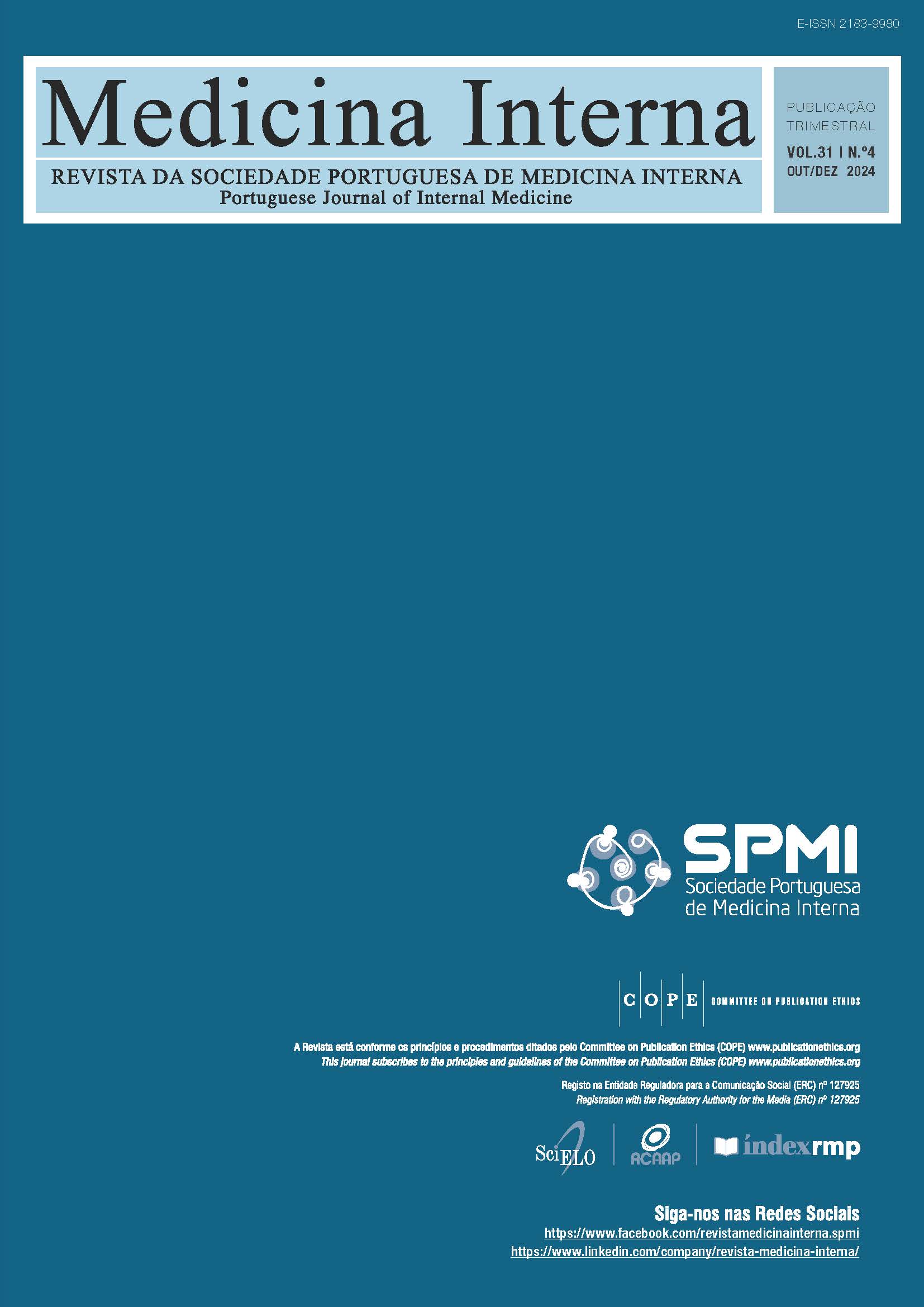Population Study of the Green and Blue Priorities in an Emergency Department
Estudo Populacional das Prioridades Verde e Azul num Serviço de Urgência
DOI:
https://doi.org/10.24950/rspmi.2512Keywords:
Admissão de Doentes, Alta do Doente, Mau Uso de Serviços de Saúde, Serviço de Urgência Hospitalar, TriagemAbstract
Introdução: A gestão do Serviço de Urgência Geral (SUG) é complexa e multifatorial, com um influxo crescente de utentes, levando a sobrelotação hospitalar, com maiores tempos de espera, desgaste profissional e menor qualidade de cuidados. Cerca de 43% dos casos em Portugal são classificados como admissões não urgentes e pouco urgentes.
Métodos: Este estudo observacional retrospetivo foi realizado no SUG de um hospital distrital de Portugal, de outubro de 2018 a maio de 2019. Foram incluídos adultos com prioridade verde e azul na triagem. O destino na alta e o número de admissões à urgência foram analisados, com associações examinadas em relação à idade, modo de proveniência, ativação de via azul e acesso a cuidados de saúde primários.
Resultados: Incluímos 41 066 episódios, a maioria deles com prioridade verde (99,9%). A maioria dos doentes, 98,8%, teve alta para cuidados ambulatórios. Os frequent flyers (≥ 4 admissões) constituíam 3,3% dos doentes e os high users (≥ 10
admissões) 0,3%. A análise mostrou associações significativas entre o destino à data de alta com a idade, com a proveniência e com a ativação da via azul (p <0,001). Houve ainda uma associação estatisticamente muito significativa entre o número de admissões e a idade (p <0,001) e o número de admissões e a capacidade de acesso aos CSP (p <0,001).
Conclusão: O estudo destaca a importância de vários fatores no destino dos doentes, mostrando uma forte associação entre a idade e a probabilidade de internamento. Além disso, a forma de chegada ao SUG e a ativação da via azul também se associam com o destino do doente. No entanto, são necessários mais estudos para entender os problemas sistémicos do SUG.
Downloads
References
Rocha PA. A Procura de Cuidados de Saúde Urgentes em Portugal [Tese de Mestrado em Evidência e Decisão em Saúde, Universidade Nova de Lisboa]. Lisboa: UNL; 2020.
Farrohknia N, Castrén M, Ehrenberg A, Lind L, Oredsson S, Jonsson H, et al. Emergency department triage scales and their components: a systematic review of the scientific evidence. Scand J Trauma Resusc Emerg Med. 2011;19:42. doi: 10.1186/1757-7241-19-42.
Ministério da Saúde, Grupo de Trabalho Serviços de Urgência. Relatório Grupo Trabalho – Serviços de Urgências: 2019. [consultado Set 2023] Disponível em: https://www.sns.gov.pt/wp-content/uploads/2019/11/RELATORIO-GT-Urgências.pdf
Ministério da Saúde, Serviços Partilhados do Ministério da Saúde. Portal de Transparência do Serviço Nacional de Saúde. Atendimentos em Urgência Hospitalar por Triagem de Manchester, Dados 2018-2022. [consultado Set 2023] Disponível em: https://transparencia.sns.gov.pt/
Bernstein SL, Aronsky D, Duseja R, Epstein S, Handel D, Hwang U, et al. The effect of emergency department crowding on clinically oriented outcomes. Acad Emerg Med. 2009;16:1-10. doi: 10.1111/j.1553-2712.2008.00295.x.
Pines JM, Hilton JA, Weber EJ, Alkemade AJ, Al Shabanah H, Anderson PD, et al. International perspectives on emergency department crowding. Acad Emerg Med. 2011;18:1358-70. doi: 10.1111/j.1553-2712.2011.01235.x.
Direção-Geral de Saúde, Departamento de Qualidade na Saúde. Manual de Standards: Unidades de Urgência e Emergência. Cempalavras – Comunicação Empresarial. Lisboa:DGS; 2016.
Van den Heede K, Van de Voorde C. Interventions to reduce emergency department utilisation: A review of reviews. Health Policy. 2016;120:1337-49. doi: 10.1016/j.healthpol.2016.10.002.
Lauks J, Mramor B, Baumgartl K, Maier H, Nickel CH, Bingisser R. Medical Team Evaluation: Effect on Emergency Department Waiting Time and Length of Stay. PLoS One. 2016;11:e0154372. doi: 10.1371/journal.pone.0154372.
Kauppila T, Seppänen K, Mattila J, Kaartinen J. The effect on the patient flow in a local health care after implementing reverse triage in a primary care emergency department: a longitudinal follow-up study. Scand J Prim Health Care. 2017;35:214-20. doi: 10.1080/02813432.2017.1333320.
Weston V, Jain SK, Gottlieb M, Aldeen A, Gravenor S, Schmidt MJ, et al. Effectiveness of Resident Physicians as Triage Liaison Providers in an Academic Emergency Department. West J Emerg Med. 2017;18:577-84. doi: 10.5811/westjem.2017.1.33243.
Carret ML, Fassa AC, Domingues MR. Inappropriate use of emergency services: a systematic review of prevalence and associated factors. Cad Saude Publica. 2009;25:7-28. doi: 10.1590/s0102-311x2009000100002.
von Elm E, Altman DG, Egger M, Pocock SJ, Gøtzsche PC, Vandenbroucke JP, et al. The Strengthening the Reporting of Observational Studies in Epidemiology (STROBE) statement: guidelines for reporting observational studies. J Clin Epidemiol. 2008;61:344-9. doi: 10.1016/j.jclinepi.2007.11.008.
Benjamin DJ, Berger JO, Johannesson M, Nosek BA, Wagenmakers EJ, Berk R, Bollen KA, et al. Redefine statistical significance. Nat Hum Behav. 2018;2:6-10. doi: 10.1038/s41562-017-0189-z.
Benjamin DJ, Berger JO. Three Recommendations for Improving the Use of p-Values. Am Statistician. 2019;73:186-91. doi:
1080/00031305.2018.1543135.
Downloads
Published
How to Cite
Issue
Section
Categories
License
Copyright (c) 2024 Internal Medicine

This work is licensed under a Creative Commons Attribution 4.0 International License.
Copyright (c) 2023 Medicina Interna






